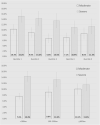Impact of Socioeconomic Status and Residence Distance on Infant Heart Disease Outcomes in Canada
- PMID: 36073651
- PMCID: PMC9683652
- DOI: 10.1161/JAHA.122.026627
Impact of Socioeconomic Status and Residence Distance on Infant Heart Disease Outcomes in Canada
Abstract
Background Socioeconomic status (SES) impacts clinical outcomes associated with severe congenital heart disease (sCHD). We examined the impact of SES and remoteness of residence (RoR) on congenital heart disease (CHD) outcomes in Canada, a jurisdiction with universal health insurance. Methods and Results All infants born in Canada (excluding Quebec) from 2008 to 2018 and hospitalized with CHD requiring intervention in the first year were identified. Neighborhood level SES income quintiles were calculated, and RoR was categorized as residing <100 km, 100 to 299 km, or >300 km from the closest of 7 cardiac surgical programs. In-hospital mortality at <1 year was the primary outcome, adjusted for preterm birth, low birth weight, and extracardiac pathology. Among 7711 infants, 4485 (58.2%) had moderate CHD (mCHD) and 3226 (41.8%) had sCHD. Overall mortality rate was 10.5%, with higher rates in sCHD than mCHD (13.3% versus 8.5%, respectively). More CHD infants were in the lowest compared with the highest SES category (27.1% versus 15.0%, respectively). The distribution of CHD across RoR categories was 52.3%, 21.3%, and 26.4% for <100 km, 100 to 299 km, and >300 km, respectively. Although SES and RoR had no impact on sCHD mortality, infants with mCHD living >300 km had a higher risk of mortality relative to those living <100 km (adjusted odds ratio [aOR], 1.43 [95% CI, 1.11-1.84]). Infants with mCHD within the lowest SES quintile and living farthest away had the highest risk for mortality (aOR, 1.74 [95% CI, 1.08-2.81]). Conclusions In Canada, neither RoR nor SES had an impact on outcomes of infants with sCHD. Greater RoR, however, may contribute to higher risk of mortality among infants with mCHD.
Keywords: clinical outcomes; congenital heart disease; population; remoteness of residence; socioeconomic status.
Figures






Similar articles
-
Impact of Remoteness of Residence and Socioeconomic Status on Outcomes Among Children With Heart Disease in Alberta.JACC Adv. 2024 Nov 7;3(11):101351. doi: 10.1016/j.jacadv.2024.101351. eCollection 2024 Nov. JACC Adv. 2024. PMID: 39553380 Free PMC article.
-
Impact of rural residence and low socioeconomic status on rate and timing of prenatal detection of major congenital heart disease in a jurisdiction of universal health coverage.Ultrasound Obstet Gynecol. 2022 Sep;60(3):359-366. doi: 10.1002/uog.26030. Ultrasound Obstet Gynecol. 2022. PMID: 35839119
-
Lower Socioeconomic Status is Associated with an Increased Incidence and Spectrum of Major Congenital Heart Disease and Associated Extracardiac Pathology.Pediatr Cardiol. 2024 Feb;45(2):433-440. doi: 10.1007/s00246-023-03310-x. Epub 2023 Oct 23. Pediatr Cardiol. 2024. PMID: 37870603
-
Socio-economic inequalities in mortality in children with congenital heart disease: A systematic review and meta-analysis.Paediatr Perinat Epidemiol. 2019 Jul;33(4):291-309. doi: 10.1111/ppe.12564. Paediatr Perinat Epidemiol. 2019. PMID: 31347722
-
Preterm congenital heart disease and neurodevelopment: the importance of looking beyond the initial hospitalization.J Perinatol. 2023 Jul;43(7):958-962. doi: 10.1038/s41372-023-01687-4. Epub 2023 May 13. J Perinatol. 2023. PMID: 37179381 Review.
Cited by
-
The 30 Years of Shifting in The Indonesian Cardiovascular Burden-Analysis of The Global Burden of Disease Study.J Epidemiol Glob Health. 2024 Mar;14(1):193-212. doi: 10.1007/s44197-024-00187-8. Epub 2024 Feb 7. J Epidemiol Glob Health. 2024. PMID: 38324147 Free PMC article.
-
Factors Associated With Lack of Long-Term Follow-Up Data After Global Cardiac Surgery Missions.World J Pediatr Congenit Heart Surg. 2024 May;15(3):325-331. doi: 10.1177/21501351241239316. Epub 2024 Apr 17. World J Pediatr Congenit Heart Surg. 2024. PMID: 38629174 Free PMC article.
-
Access to Specialized Care Across the Lifespan in Tetralogy of Fallot.CJC Pediatr Congenit Heart Dis. 2023 Sep 14;2(6Part A):267-282. doi: 10.1016/j.cjcpc.2023.09.004. eCollection 2023 Dec. CJC Pediatr Congenit Heart Dis. 2023. PMID: 38161668 Free PMC article. Review.
-
Impact of Remoteness of Residence and Socioeconomic Status on Outcomes Among Children With Heart Disease in Alberta.JACC Adv. 2024 Nov 7;3(11):101351. doi: 10.1016/j.jacadv.2024.101351. eCollection 2024 Nov. JACC Adv. 2024. PMID: 39553380 Free PMC article.
-
Socioeconomic Status and Access to Care for Pediatric and Adult Congenital Heart Disease in Universal Health Coverage Models.J Cardiovasc Dev Dis. 2024 Aug 16;11(8):250. doi: 10.3390/jcdd11080250. J Cardiovasc Dev Dis. 2024. PMID: 39195158 Free PMC article. Review.
References
-
- Zimmerman MS, Smith AGC, Sable CA, Echko MM, Wilner LB, Olsen HE, Atalay HT, Awasthi A, Bhutta ZA, Boucher JL, et al. Global, regional, and national burden of congenital heart disease, 1990–2017: a systematic analysis for the global burden of disease study 2017. Lancet Child Adolesc Heal. 2020;4:185–200. doi: 10.1016/S2352-4642(19)30402-X - DOI - PMC - PubMed
Publication types
MeSH terms
LinkOut - more resources
Full Text Sources
Medical

